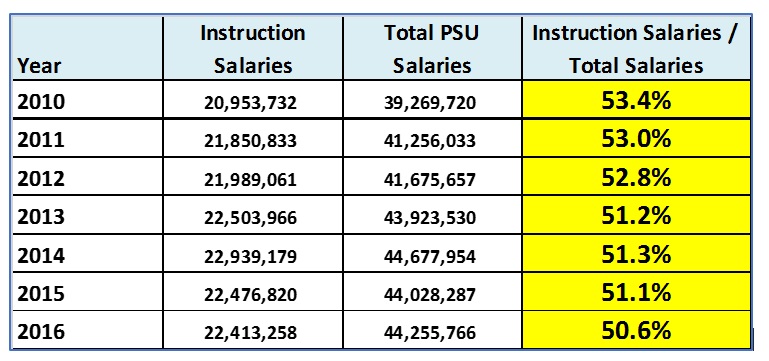 The Plymouth State University AAUP has a new analysis of PSU and USNH finances. On the bright side, the data indicate our financial position is more solid than it may have seemed. However, the report indicates investing in the classroom is a low priority for PSU.
The Plymouth State University AAUP has a new analysis of PSU and USNH finances. On the bright side, the data indicate our financial position is more solid than it may have seemed. However, the report indicates investing in the classroom is a low priority for PSU.
One of the benefits of belonging to the AAUP is access to experts in higher education accounting and finance who can provide an outside perspective on our situation. In the Fall, we requested that the administration supply us with key financial data that shows actual (not merely budgeted) revenues, expenditures, and other data. This is the same data the university is required to report to the federal government. Eastern Michigan University accounting professor, Howard Bunsis, is an AAUP leader and has a national reputation as an expert in higher ed finance and accounting. He studied PSU’s financial data for months. Today, we are able to share his detailed analysis of the PSU and USNH financial status. We’ve included the full report here (Bunsis Plymouth State report March 2018) and a summary below.
Key Findings
- PSU and USNH’s financial position is stronger than we have come to believe:

USNH Balance Sheet (amounts in thousands; Source: USNH Audited financial statements)
- Assets are increasing.
- Total expenses have not increased significantly over the last several years, remaining basically flat at $100 million for the last five years.
- PSU’s reserves have been growing, and since 2014 the rate at which the unrestricted reserves have increased has, itself, been increasing.
- Most of the reserves are unrestricted. According to Bunsis, unrestricted means unrestricted. While reserves cannot be spent down automatically, if reserves were truly inaccessible, the external auditors would not put the amounts in the unrestricted category.
- The surplus of $4 million in 2017 is the largest surplus since 2012. The decline in instructional compensation helped create this surplus.
- Spending on instruction as a percentage of all spending continues to decrease:

The percentage of total salaries at PSU devoted to instructional salaries - Total salaries and wages for instruction actually declined from 2014-2015 and from 2015 to 2016; given total compensation declined from 2016-2017, it is likely the salary costs for instruction also declined from 2016-2017.
- Total instructional salaries and benefits are less than ⅓ of total PSU expenses.
- Total instructional salaries are barely ½ of total salaries, and that percentage is declining.
- From 2009-2017, inflation was 14.2%. In that same period, salaries for full professors rose just 6.7%, salaries for associate professors rose just 10.3%, and salaries for assistant professors rose just 7.1%.
- Faculty salaries are well below peers and are losing ground. From 2013-2017, full professor salaries fell behind their peers by an additional 3.6%, associate professors fell behind by an additional 3.9%, and assistant professors lagged by an additional 6.3%.
- Spending on administration (including administrative salaries) is rising sharply:

Changes in total PSU instructional salaries compared to total administrative salaries in 2014/15 and 2015/16. - As stated above, total expenses have not increased significantly over the last several years, but the portion of spending that goes to administration has been rising steadily.
- In 2015, salaries for administration (referred to in the data as “institutional support”) increased by over $100K while salaries for instruction decreased by over $460K.
- In 2016, salaries for administration increased by over $760K while salaries for instruction decreased by over $60K.
- To put this in perspective, each percentage point raise in tenured/tenure-track faculty salaries costs approximately $186K (or a little less than ¼ of the 2016 increase in spending on administrative salaries).
- As stated above, total expenses have not increased significantly over the last several years, but the portion of spending that goes to administration has been rising steadily.
Our negotiating team has made much progress on key issues like Workload as we bargain for our first contract. But in negotiations to date, the administration has been unwilling to make fair compensation for faculty an institutional priority.
Please read the Bunsis report and form your own conclusions.
While we are sharing this information with everyone in the bargaining unit now, on March 28, the PSU-AAUP will hold a membership meeting to discuss this latest analysis and how it should inform our position on the remaining proposals for negotiation (Salary; Benefits; Retrenchment; Promotion, Tenure & Evaluation; and Agency Fees). As we recently announced, we have now reached 100 members–that’s more than 60% of the faculty. We would like to hear from as many of those members as possible. If you have not yet joined, but would like to do so, please use this link to enroll (https://www.aaup.org/membership). Additionally, you will be able to join at the meeting.
AAUP Membership Meeting
Date: Wed. March 28
Time: 2:30 – 4:00 pm
Place: Merrill Place Multipurpose Room B
Please feel free to come at whatever time you are able and stay as long as you can. This will be an ongoing discussion, so it is OK to come late and leave early.

